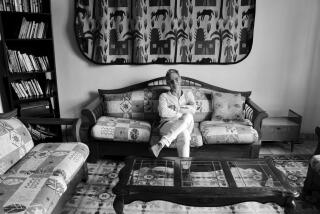Murdered Because She Understood Him : THE TUNNEL <i> by Ernesto Sabato; translated by Margaret Sayers Peden (Available Press: $4.75, paper; 138 pp.) </i>
Of Argentina’s three greatest prose writers of mid-century--Jorge Luis Borges, Julio Cortazar and Ernesto Sabato--it is Sabato who remains least known in the United States. Over a career of 40 years, he has produced only half a dozen or so books, but that work has made him one of the most revered and honored figures in Hispanic letters.
“The Tunnel,” Sabato’s first and shortest fiction, appeared to great acclaim in Buenos Aires in 1948 and soon after was hailed in Europe by the likes of Albert Camus and Graham Greene. A translation was published in the United States in 1951 but is long out of print. Now, Available Press has issued a new English rendition for the American audience.
The story begins in a prison, as the painter Juan Pablo Castel narrates the tale of his passion for, his obsession with, and his eventual murder of Maria Iribarne, a woman he first met at an exhibition of his work. Her interest in an apparently minor detail of one painting sends the unstable artist on a nightmare journey into desire, jealousy and violence. The text, brief and unsparing, chronicles a mind’s unmooring, as Castel, the proud logician, master of a cool and “architectural” style, consistently misreads, overinterprets or simply imagines events in a vicious circle in which his own madness feeds on itself to the point that he destroys the very person who most profoundly understands him.
If, in the time since its publication, some of the rhetoric of this novel, written in the years of existentialism’s full flower, strikes the ear as curiously overwrought, the power of Sabato’s story remains. Too, he delivers several satisfying satirical thrusts at the vagaries of the life of the urban intellectual that retain a remarkable contemporary resonance. His deadpan description of a cocktail party filled with psychoanalysts, his evocation of the shallow chit-chat of Argentina’s moneyed elite, are right on target and include not entirely subtle digs at certain of his fellow writers. In his exposition of not only Castel’s desire but Maria Iribarne’s as well, Sabato captures the intensity of passions run into uncharted passages where love promises not tranquillity but danger. Finally, the novel sets forth many of Sabato’s own obsessions--the tenuousness of logic, the elusiveness of art’s power, the mystery of sex and the power, both as state and symbol, of blindness--to which he returns in his subsequent, longer novels--”On Heroes and Tombs” (now also available in English) and “Abadon, el exterminador.”
In “The Tunnel,” there is an ugly irony relevant to Sabato’s career, one he could not have foreseen, of course, when he sat down in his 30s to pen the story of one man’s descent into paranoia and violence. Some 35 years later, the author found himself the chairman of “The National Commission on the Disappearance of Persons” (CONADEP), the organ established by the newly democratic government to investigate the horror wrought upon Argentina by the military government of the late 1970s. Sabato must have been uniquely chilled at the stories of national institutions justifying the most unconscionable acts on the basis of the very sort of flawed logic, the very kind of perverted attachment to the highest ideals, that had propelled Juan Pablo Castel to murder and self-destruction in Sabato’s imagination so many years before.
More to Read
Sign up for our Book Club newsletter
Get the latest news, events and more from the Los Angeles Times Book Club, and help us get L.A. reading and talking.
You may occasionally receive promotional content from the Los Angeles Times.






